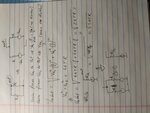fabio_807
Newbie level 3
Hello,
Is the noise for 2 parallel resistors equal or less than their parallel equivalent. Or to put some numbers Vnoise (2Meg || 2Meg) vs Vn(1Meg).
In my estimate it is Vn(1M)/sqrt(2).
Thank you and nice to meet you guys
Fabio
Is the noise for 2 parallel resistors equal or less than their parallel equivalent. Or to put some numbers Vnoise (2Meg || 2Meg) vs Vn(1Meg).
In my estimate it is Vn(1M)/sqrt(2).
Thank you and nice to meet you guys
Fabio
